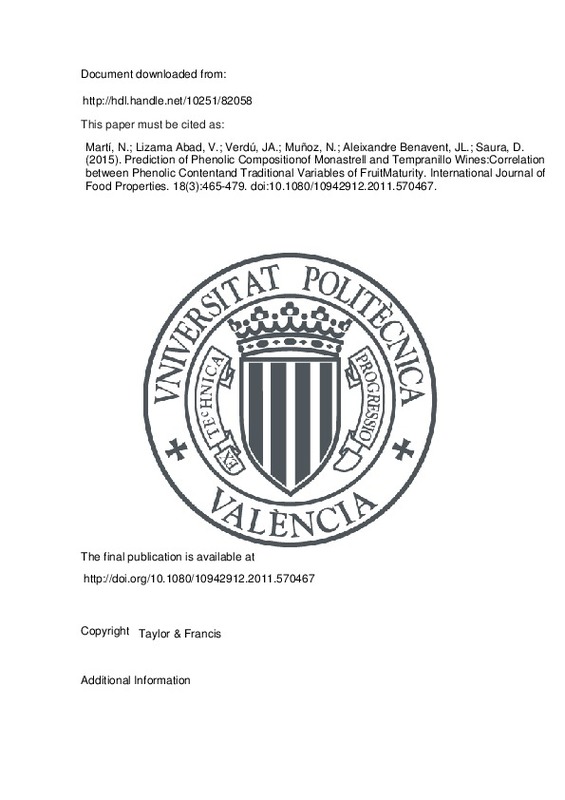JavaScript is disabled for your browser. Some features of this site may not work without it.
Buscar en RiuNet
Listar
Mi cuenta
Estadísticas
Ayuda RiuNet
Admin. UPV
Prediction of Phenolic Compositionof Monastrell and Tempranillo Wines:Correlation between Phenolic Contentand Traditional Variables of FruitMaturity
Mostrar el registro sencillo del ítem
Ficheros en el ítem
| dc.contributor.author | Martí, N.
|
es_ES |
| dc.contributor.author | Lizama Abad, Victoria
|
es_ES |
| dc.contributor.author | Verdú, J. A.
|
es_ES |
| dc.contributor.author | Muñoz, N.
|
es_ES |
| dc.contributor.author | Aleixandre Benavent, José Luís
|
es_ES |
| dc.contributor.author | Saura, D.
|
es_ES |
| dc.date.accessioned | 2017-05-31T07:08:21Z | |
| dc.date.available | 2017-05-31T07:08:21Z | |
| dc.date.issued | 2015 | |
| dc.identifier.issn | 1094-2912 | |
| dc.identifier.uri | http://hdl.handle.net/10251/82058 | |
| dc.description.abstract | [EN] Color is one of the most important factors in the quality assessment of red wine. Polyphenolic compounds, located in the skin and seeds of grapes, are responsible for the color of both the fruit and the wine produced from that fruit. In the present research, the level of phenolic maturity of Monastrell and Tempranillo grapes at their time of arrival to the winery was investigated. To this end, parameters defining color and polyphenol content in wines produced from these grapes were contrasted with parameters typically associated with general and phenolic grape maturity. The main aim of this research was to uncover the nature of the relationship between these parameters, such that, by knowing the characteristics of the grapes, predictions could be made regarding the characteristics of the resulting wine. The capacity to objectively assess and predict the potential quality and enological fitness of a given lot of Monastrell and Tempranillo grapes would greatly facilitate selection of the style of vinification best suited to this fruit. | es_ES |
| dc.language | Inglés | es_ES |
| dc.publisher | Taylor & Francis | es_ES |
| dc.relation.ispartof | International Journal of Food Properties | es_ES |
| dc.rights | Reserva de todos los derechos | es_ES |
| dc.subject | Polyphenols | es_ES |
| dc.subject | Extractability | es_ES |
| dc.subject | Monastrell | es_ES |
| dc.subject | Tempranillo. | es_ES |
| dc.subject.classification | TECNOLOGIA DE ALIMENTOS | es_ES |
| dc.title | Prediction of Phenolic Compositionof Monastrell and Tempranillo Wines:Correlation between Phenolic Contentand Traditional Variables of FruitMaturity | es_ES |
| dc.type | Artículo | es_ES |
| dc.identifier.doi | 10.1080/10942912.2011.570467 | |
| dc.rights.accessRights | Abierto | es_ES |
| dc.contributor.affiliation | Universitat Politècnica de València. Instituto Universitario de Ingeniería de Alimentos para el Desarrollo - Institut Universitari d'Enginyeria d'Aliments per al Desenvolupament | es_ES |
| dc.contributor.affiliation | Universitat Politècnica de València. Escuela Técnica Superior de Ingeniería Agronómica y del Medio Natural - Escola Tècnica Superior d'Enginyeria Agronòmica i del Medi Natural | es_ES |
| dc.description.bibliographicCitation | Martí, N.; Lizama Abad, V.; Verdú, JA.; Muñoz, N.; Aleixandre Benavent, JL.; Saura, D. (2015). Prediction of Phenolic Compositionof Monastrell and Tempranillo Wines:Correlation between Phenolic Contentand Traditional Variables of FruitMaturity. International Journal of Food Properties. 18(3):465-479. https://doi.org/10.1080/10942912.2011.570467 | es_ES |
| dc.description.accrualMethod | S | es_ES |
| dc.relation.publisherversion | http://doi.org/10.1080/10942912.2011.570467 | es_ES |
| dc.description.upvformatpinicio | 465 | es_ES |
| dc.description.upvformatpfin | 479 | es_ES |
| dc.type.version | info:eu-repo/semantics/publishedVersion | es_ES |
| dc.description.volume | 18 | es_ES |
| dc.description.issue | 3 | es_ES |
| dc.relation.senia | 290775 | es_ES |
| dc.identifier.eissn | 1532-2386 |







![[Cerrado]](/themes/UPV/images/candado.png)

